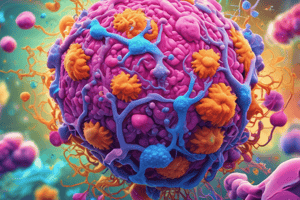Podcast
Questions and Answers
What is viral pathogenesis?
What is viral pathogenesis?
- The methods to prevent viral infections
- The classification of viruses based on their pathogenicity
- The processes by which viral infections cause diseases (correct)
- The study of viral replication
What is tropism in the context of viral pathogenesis?
What is tropism in the context of viral pathogenesis?
- The process of viral replication within the host cell
- The mechanism by which viruses evade the immune system
- Susceptibility, permissiveness, and accessibility of cells to viral infection (correct)
- The ability of viruses to mutate rapidly
Where do DNA viruses typically replicate?
Where do DNA viruses typically replicate?
- In the cytoplasm of the host cell
- In the endoplasmic reticulum
- In the nucleus of the host cell (correct)
- Within the cell membrane
What are some common points in the virus life cycle shared between all pathogenic viruses?
What are some common points in the virus life cycle shared between all pathogenic viruses?
What is the outcome of failed virus infection?
What is the outcome of failed virus infection?
What is the outcome of lytic non-cytocidal infection?
What is the outcome of lytic non-cytocidal infection?
Which virus is latent in sacral or lumbar ganglia?
Which virus is latent in sacral or lumbar ganglia?
What is the global prevalence of HSV-1 in 0–49-year-olds?
What is the global prevalence of HSV-1 in 0–49-year-olds?
Which virus is the causative agent of genital herpes?
Which virus is the causative agent of genital herpes?
Where does HSV-1 establish latency?
Where does HSV-1 establish latency?
What occurs during reactivation of HSV?
What occurs during reactivation of HSV?
What type of genes are immediate early (IE) genes in HSV pathogenesis?
What type of genes are immediate early (IE) genes in HSV pathogenesis?
Where does HSV-2 establish latency?
Where does HSV-2 establish latency?
What are the clinical symptoms associated with primary HSV-2 infection?
What are the clinical symptoms associated with primary HSV-2 infection?
What happens during latency of HSV?
What happens during latency of HSV?
What is the function of LAT genes during latency in herpes simplex virus (HSV) infection?
What is the function of LAT genes during latency in herpes simplex virus (HSV) infection?
Which viral protein inhibits type I interferon-mediated responses in infected cells during HSV infection?
Which viral protein inhibits type I interferon-mediated responses in infected cells during HSV infection?
What is the primary mode of transmission for human papillomavirus (HPV)?
What is the primary mode of transmission for human papillomavirus (HPV)?
Which HPV types are associated with cervical cancer?
Which HPV types are associated with cervical cancer?
What is the genome type of human papillomavirus (HPV)?
What is the genome type of human papillomavirus (HPV)?
"Glycoprotein E" of HSV has which ability?
"Glycoprotein E" of HSV has which ability?
During latency in herpes simplex virus (HSV) infection, what happens to the viral lytic genes?
During latency in herpes simplex virus (HSV) infection, what happens to the viral lytic genes?
What can cause reactivation of herpes simplex virus (HSV) from latency?
What can cause reactivation of herpes simplex virus (HSV) from latency?
How does Human Papillomavirus (HPV) transmit through direct contact?
How does Human Papillomavirus (HPV) transmit through direct contact?
What is the association between HPV-16 and HPV-18 with cervical squamous neoplasia?
What is the association between HPV-16 and HPV-18 with cervical squamous neoplasia?
What can HPV infection cause?
What can HPV infection cause?
Study Notes
- The genes associated with latency (LAT) are expressed when a virus enters latency.
- During latency, only the LAT genes are expressed, and all other viral lytic genes are repressed.
- Expression of LATs inhibits apoptosis (programmed cell death), promoting the survival of infected cells.
- Latent viral episomes bind to the cellular chromatin.
- Herpes Simplex Virus (HSV) employs multiple strategies to evade the immune system:
- Virus Host Shut Off Protein (vhs) and Infected Cell Protein 0 (ICP0): inhibit type I interferon-mediated responses in infected cells.
- Glycoprotein C: binds and inactivates C3b component of complement.
- Glycoprotein E: has Fc binding ability.
- HSV encoded protein ICP47 binds to the MHC class I TAP transporter, inhibiting transport of virus peptide and presentation to the immune system.
- HSV can reactivate from latency due to cellular factors and external stimuli, such as UV light, stress, fever, tissue damage, and immune suppression.
- Reactivation can occur in the absence of clinical symptoms, and HSV-2 sheds virus during asymptomatic reactivation, which is a significant means of transmission.
- Human Papillomavirus (HPV) is a non-enveloped virus with a circular, ds DNA genome between 6.8kb and 8.4kb.
- HPV is ubiquitous, and up to 80% of people are exposed to it.
- HPV is classified into over 200 types, and causes benign to potentially malignant proliferative lesions.
- HPV is the fourth most common cancer among women globally, and high-risk HPV types (HPV-16, 18, 31, 33, 35, 39, 45, 51, 52, 56, 58, 59, and 68) are associated with cervical cancer.
- HPV transmits through direct contact, particularly sexual contact.
- HPV infection causes cell proliferation, and some HPV types can progress to malignancy through genome integration and continued cell replication, along with accumulating mutations.
- HPV-16 and HPV-18 are associated with cervical squamous neoplasia due to their E6 and E7 gene products, which inactivate normal functions of the p53 and Rb proteins, respectively.
- HPV oncogenic transformation is coincident with the integration of papillomavirus DNA into cellular DNA and the expression of E6, E7 without virus production, which may lead to neoplasia and eventually metastasis.
- HPV infects epithelial cells of the skin and mucus membranes and replicates according to the stage of epithelial cell differentiation.
- HPV can cause benign overgrowth of cells into warts, and some HPV types are associated with dysplasia that can become cancerous.
Studying That Suits You
Use AI to generate personalized quizzes and flashcards to suit your learning preferences.
Related Documents
Description
Explore the principles of viral pathogenesis and mechanisms of viral infections causing diseases, including latency, transformation, chronic infection, and evolution of viruses to evade the immune system.




